Financial Accounting and Reporting Analysis Report, HA2032
VerifiedAdded on 2023/06/04
|11
|2715
|329
Report
AI Summary
This report provides a comprehensive analysis of financial management, focusing on the regulation and disclosure of financial accounting and reporting. It delves into the significance of financial accounting and reporting, exploring the roles of the Australian Accounting Standards Board (AASB) and International Financial Reporting Standards (IFRS). The report assesses the need for regulation versus voluntary disclosure of financial information, highlighting the importance of transparency and standardization. Furthermore, it examines the equity and debt of four ASX-listed companies (Amcor Limited, Alto Metals Limited, Admiralty Resources NL, and Adelaide Brighton Limited) over four consecutive years, providing detailed analyses of their financial statements. The report includes a comparative analysis of the debt-to-equity ratios, offering insights into the financial leverage of these companies. The report concludes with a summary of key findings and observations regarding corporate and financial accounting practices.
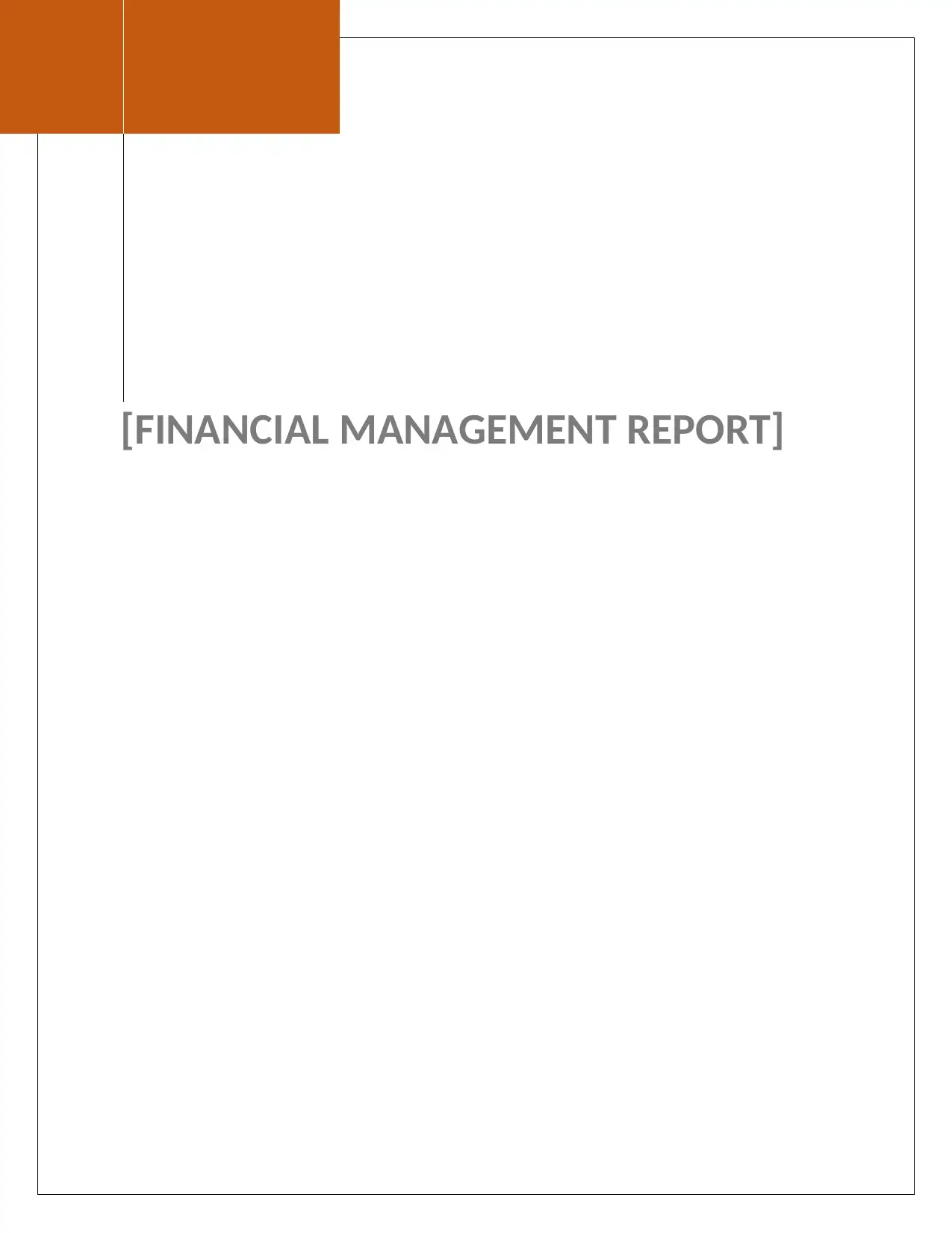
[FINANCIAL MANAGEMENT REPORT]
Paraphrase This Document
Need a fresh take? Get an instant paraphrase of this document with our AI Paraphraser
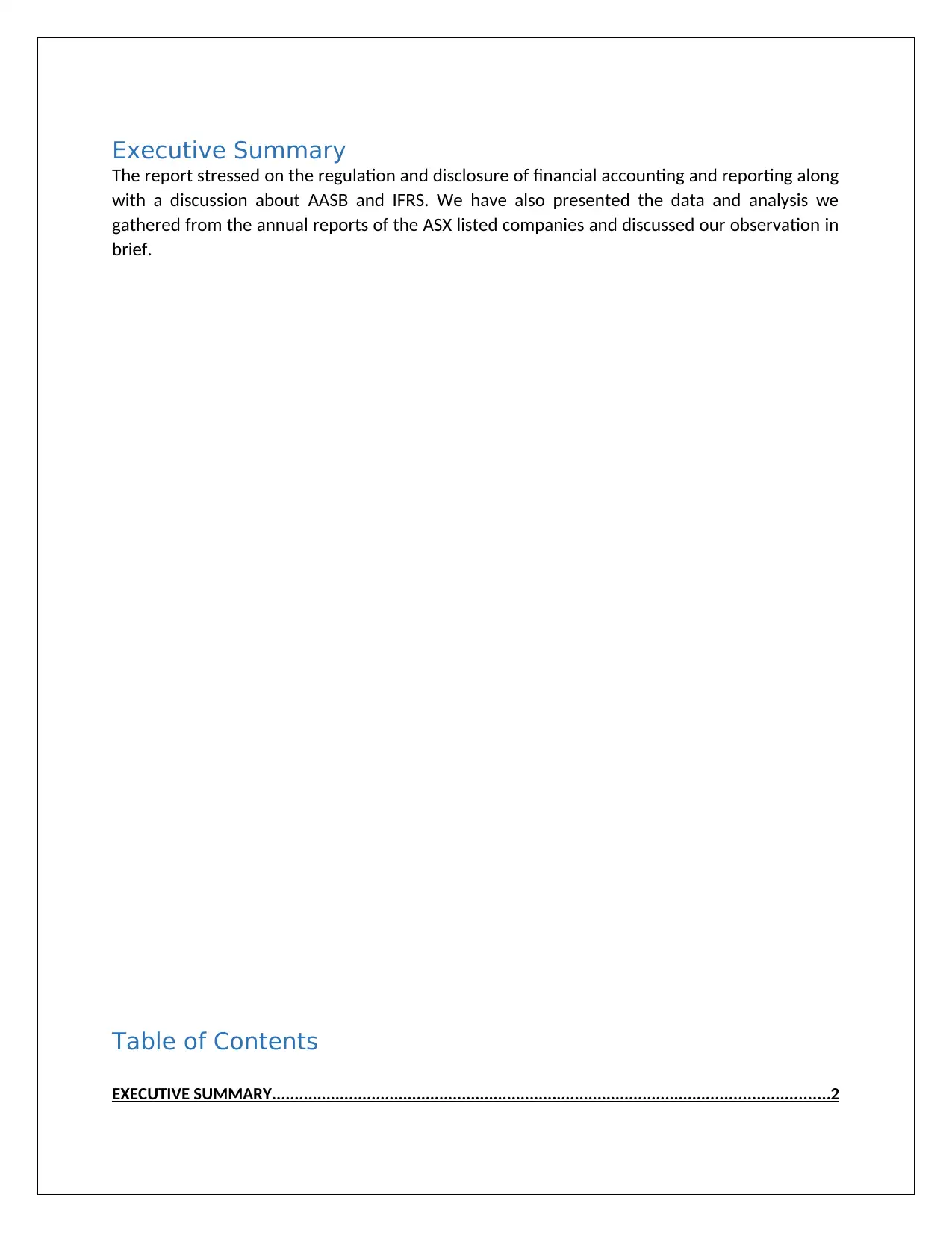
Executive Summary
The report stressed on the regulation and disclosure of financial accounting and reporting along
with a discussion about AASB and IFRS. We have also presented the data and analysis we
gathered from the annual reports of the ASX listed companies and discussed our observation in
brief.
Table of Contents
EXECUTIVE SUMMARY...........................................................................................................................2
The report stressed on the regulation and disclosure of financial accounting and reporting along
with a discussion about AASB and IFRS. We have also presented the data and analysis we
gathered from the annual reports of the ASX listed companies and discussed our observation in
brief.
Table of Contents
EXECUTIVE SUMMARY...........................................................................................................................2
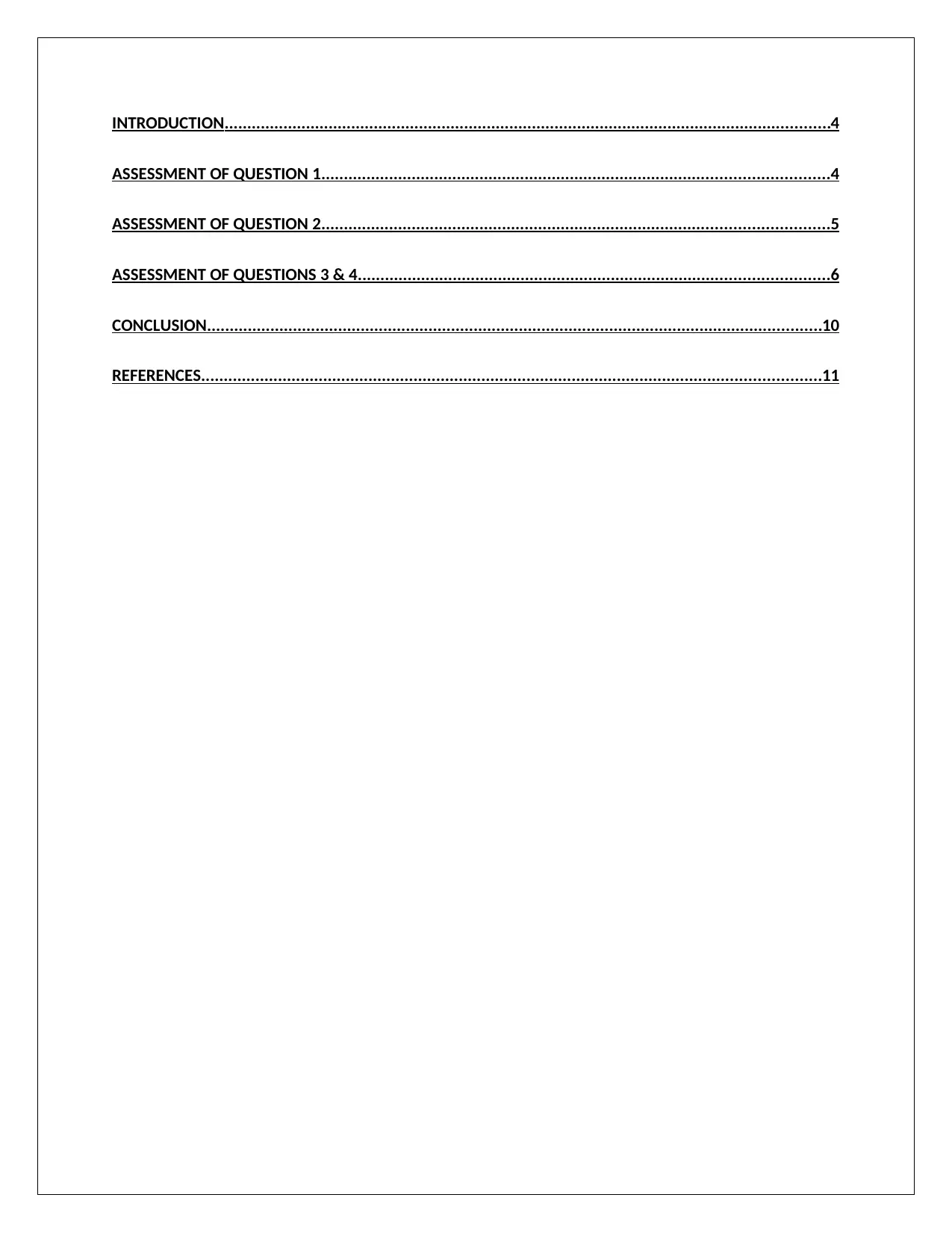
INTRODUCTION......................................................................................................................................4
ASSESSMENT OF QUESTION 1................................................................................................................4
ASSESSMENT OF QUESTION 2................................................................................................................5
ASSESSMENT OF QUESTIONS 3 & 4........................................................................................................6
CONCLUSION........................................................................................................................................10
REFERENCES.........................................................................................................................................11
ASSESSMENT OF QUESTION 1................................................................................................................4
ASSESSMENT OF QUESTION 2................................................................................................................5
ASSESSMENT OF QUESTIONS 3 & 4........................................................................................................6
CONCLUSION........................................................................................................................................10
REFERENCES.........................................................................................................................................11
⊘ This is a preview!⊘
Do you want full access?
Subscribe today to unlock all pages.

Trusted by 1+ million students worldwide
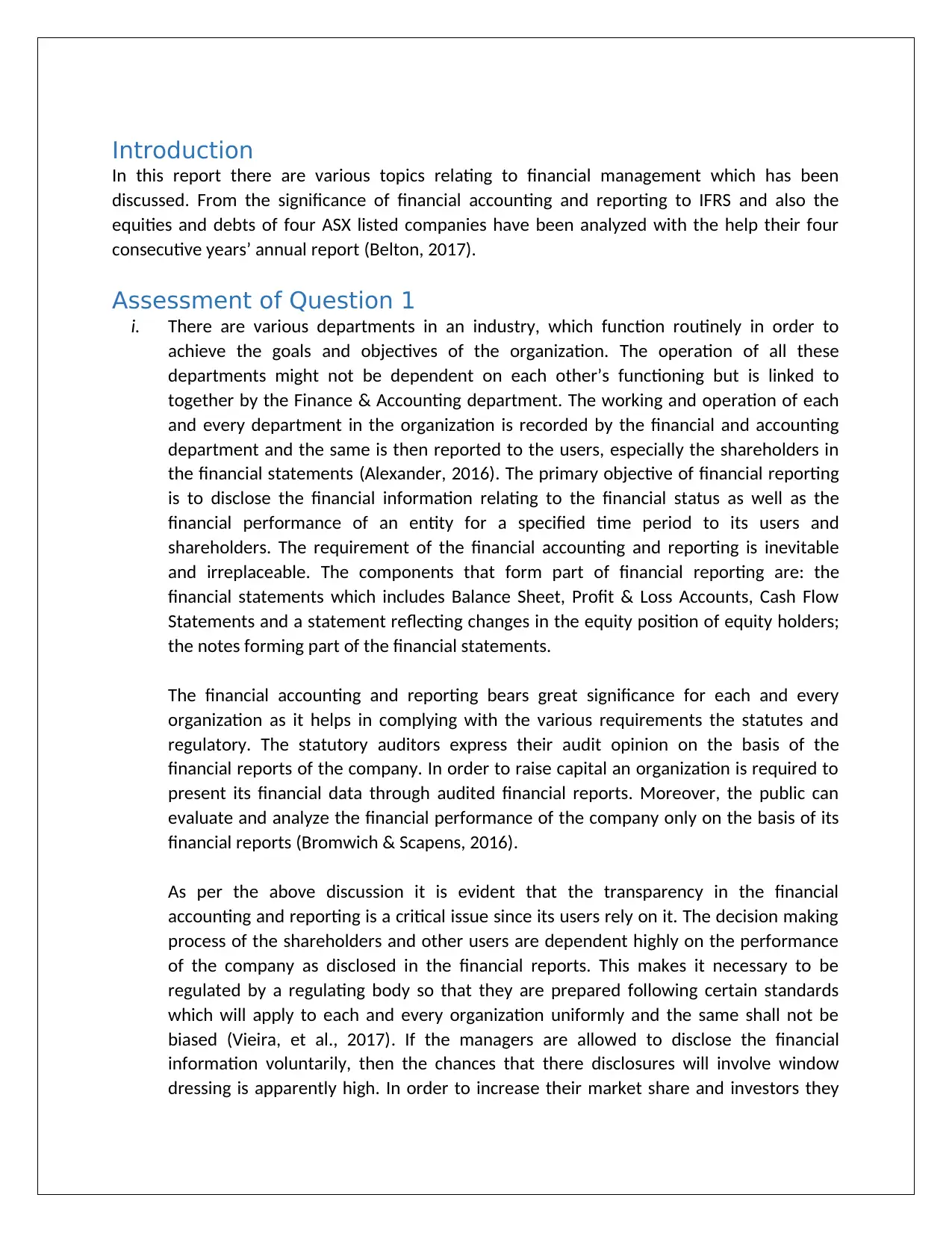
Introduction
In this report there are various topics relating to financial management which has been
discussed. From the significance of financial accounting and reporting to IFRS and also the
equities and debts of four ASX listed companies have been analyzed with the help their four
consecutive years’ annual report (Belton, 2017).
Assessment of Question 1
i. There are various departments in an industry, which function routinely in order to
achieve the goals and objectives of the organization. The operation of all these
departments might not be dependent on each other’s functioning but is linked to
together by the Finance & Accounting department. The working and operation of each
and every department in the organization is recorded by the financial and accounting
department and the same is then reported to the users, especially the shareholders in
the financial statements (Alexander, 2016). The primary objective of financial reporting
is to disclose the financial information relating to the financial status as well as the
financial performance of an entity for a specified time period to its users and
shareholders. The requirement of the financial accounting and reporting is inevitable
and irreplaceable. The components that form part of financial reporting are: the
financial statements which includes Balance Sheet, Profit & Loss Accounts, Cash Flow
Statements and a statement reflecting changes in the equity position of equity holders;
the notes forming part of the financial statements.
The financial accounting and reporting bears great significance for each and every
organization as it helps in complying with the various requirements the statutes and
regulatory. The statutory auditors express their audit opinion on the basis of the
financial reports of the company. In order to raise capital an organization is required to
present its financial data through audited financial reports. Moreover, the public can
evaluate and analyze the financial performance of the company only on the basis of its
financial reports (Bromwich & Scapens, 2016).
As per the above discussion it is evident that the transparency in the financial
accounting and reporting is a critical issue since its users rely on it. The decision making
process of the shareholders and other users are dependent highly on the performance
of the company as disclosed in the financial reports. This makes it necessary to be
regulated by a regulating body so that they are prepared following certain standards
which will apply to each and every organization uniformly and the same shall not be
biased (Vieira, et al., 2017). If the managers are allowed to disclose the financial
information voluntarily, then the chances that there disclosures will involve window
dressing is apparently high. In order to increase their market share and investors they
In this report there are various topics relating to financial management which has been
discussed. From the significance of financial accounting and reporting to IFRS and also the
equities and debts of four ASX listed companies have been analyzed with the help their four
consecutive years’ annual report (Belton, 2017).
Assessment of Question 1
i. There are various departments in an industry, which function routinely in order to
achieve the goals and objectives of the organization. The operation of all these
departments might not be dependent on each other’s functioning but is linked to
together by the Finance & Accounting department. The working and operation of each
and every department in the organization is recorded by the financial and accounting
department and the same is then reported to the users, especially the shareholders in
the financial statements (Alexander, 2016). The primary objective of financial reporting
is to disclose the financial information relating to the financial status as well as the
financial performance of an entity for a specified time period to its users and
shareholders. The requirement of the financial accounting and reporting is inevitable
and irreplaceable. The components that form part of financial reporting are: the
financial statements which includes Balance Sheet, Profit & Loss Accounts, Cash Flow
Statements and a statement reflecting changes in the equity position of equity holders;
the notes forming part of the financial statements.
The financial accounting and reporting bears great significance for each and every
organization as it helps in complying with the various requirements the statutes and
regulatory. The statutory auditors express their audit opinion on the basis of the
financial reports of the company. In order to raise capital an organization is required to
present its financial data through audited financial reports. Moreover, the public can
evaluate and analyze the financial performance of the company only on the basis of its
financial reports (Bromwich & Scapens, 2016).
As per the above discussion it is evident that the transparency in the financial
accounting and reporting is a critical issue since its users rely on it. The decision making
process of the shareholders and other users are dependent highly on the performance
of the company as disclosed in the financial reports. This makes it necessary to be
regulated by a regulating body so that they are prepared following certain standards
which will apply to each and every organization uniformly and the same shall not be
biased (Vieira, et al., 2017). If the managers are allowed to disclose the financial
information voluntarily, then the chances that there disclosures will involve window
dressing is apparently high. In order to increase their market share and investors they
Paraphrase This Document
Need a fresh take? Get an instant paraphrase of this document with our AI Paraphraser
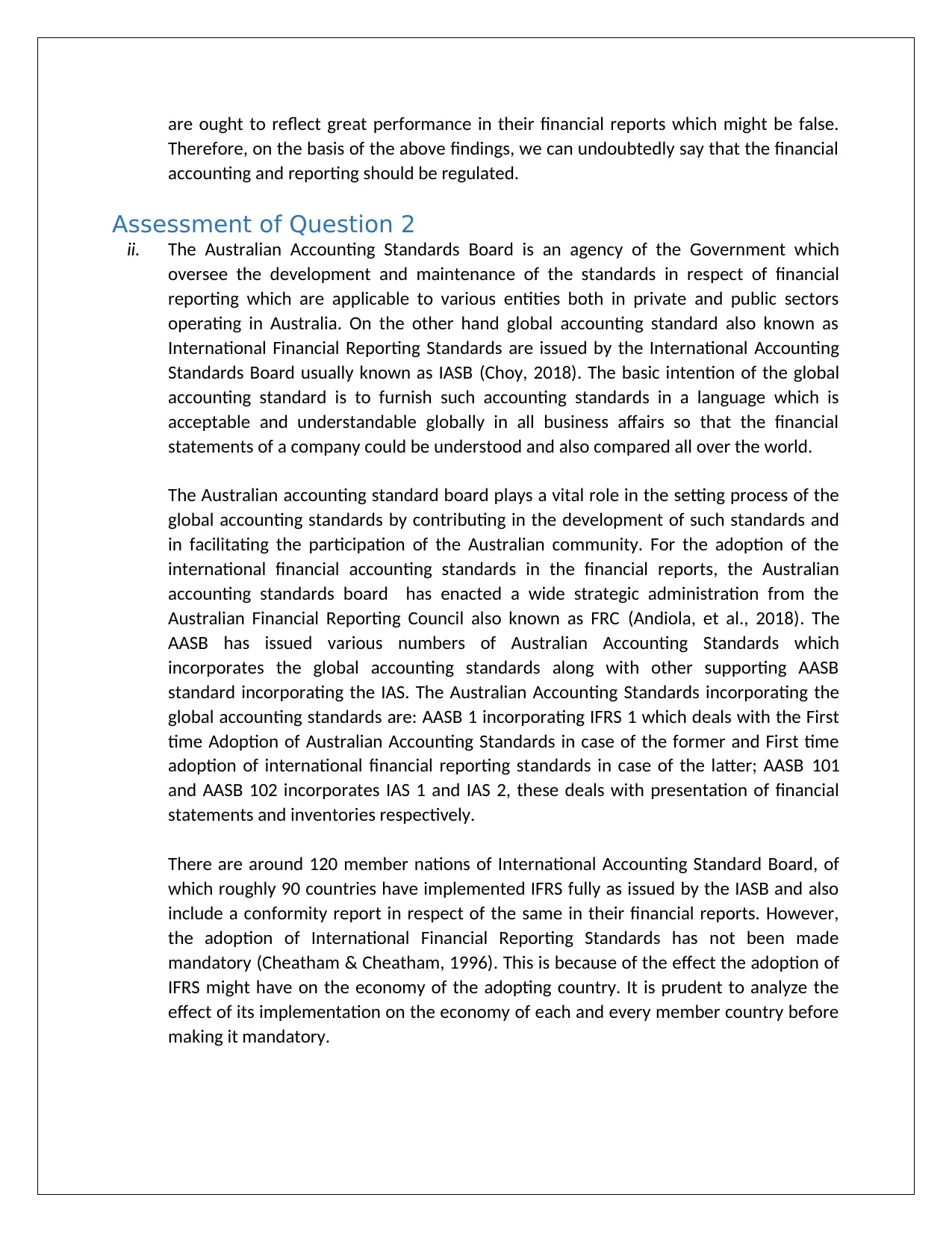
are ought to reflect great performance in their financial reports which might be false.
Therefore, on the basis of the above findings, we can undoubtedly say that the financial
accounting and reporting should be regulated.
Assessment of Question 2
ii. The Australian Accounting Standards Board is an agency of the Government which
oversee the development and maintenance of the standards in respect of financial
reporting which are applicable to various entities both in private and public sectors
operating in Australia. On the other hand global accounting standard also known as
International Financial Reporting Standards are issued by the International Accounting
Standards Board usually known as IASB (Choy, 2018). The basic intention of the global
accounting standard is to furnish such accounting standards in a language which is
acceptable and understandable globally in all business affairs so that the financial
statements of a company could be understood and also compared all over the world.
The Australian accounting standard board plays a vital role in the setting process of the
global accounting standards by contributing in the development of such standards and
in facilitating the participation of the Australian community. For the adoption of the
international financial accounting standards in the financial reports, the Australian
accounting standards board has enacted a wide strategic administration from the
Australian Financial Reporting Council also known as FRC (Andiola, et al., 2018). The
AASB has issued various numbers of Australian Accounting Standards which
incorporates the global accounting standards along with other supporting AASB
standard incorporating the IAS. The Australian Accounting Standards incorporating the
global accounting standards are: AASB 1 incorporating IFRS 1 which deals with the First
time Adoption of Australian Accounting Standards in case of the former and First time
adoption of international financial reporting standards in case of the latter; AASB 101
and AASB 102 incorporates IAS 1 and IAS 2, these deals with presentation of financial
statements and inventories respectively.
There are around 120 member nations of International Accounting Standard Board, of
which roughly 90 countries have implemented IFRS fully as issued by the IASB and also
include a conformity report in respect of the same in their financial reports. However,
the adoption of International Financial Reporting Standards has not been made
mandatory (Cheatham & Cheatham, 1996). This is because of the effect the adoption of
IFRS might have on the economy of the adopting country. It is prudent to analyze the
effect of its implementation on the economy of each and every member country before
making it mandatory.
Therefore, on the basis of the above findings, we can undoubtedly say that the financial
accounting and reporting should be regulated.
Assessment of Question 2
ii. The Australian Accounting Standards Board is an agency of the Government which
oversee the development and maintenance of the standards in respect of financial
reporting which are applicable to various entities both in private and public sectors
operating in Australia. On the other hand global accounting standard also known as
International Financial Reporting Standards are issued by the International Accounting
Standards Board usually known as IASB (Choy, 2018). The basic intention of the global
accounting standard is to furnish such accounting standards in a language which is
acceptable and understandable globally in all business affairs so that the financial
statements of a company could be understood and also compared all over the world.
The Australian accounting standard board plays a vital role in the setting process of the
global accounting standards by contributing in the development of such standards and
in facilitating the participation of the Australian community. For the adoption of the
international financial accounting standards in the financial reports, the Australian
accounting standards board has enacted a wide strategic administration from the
Australian Financial Reporting Council also known as FRC (Andiola, et al., 2018). The
AASB has issued various numbers of Australian Accounting Standards which
incorporates the global accounting standards along with other supporting AASB
standard incorporating the IAS. The Australian Accounting Standards incorporating the
global accounting standards are: AASB 1 incorporating IFRS 1 which deals with the First
time Adoption of Australian Accounting Standards in case of the former and First time
adoption of international financial reporting standards in case of the latter; AASB 101
and AASB 102 incorporates IAS 1 and IAS 2, these deals with presentation of financial
statements and inventories respectively.
There are around 120 member nations of International Accounting Standard Board, of
which roughly 90 countries have implemented IFRS fully as issued by the IASB and also
include a conformity report in respect of the same in their financial reports. However,
the adoption of International Financial Reporting Standards has not been made
mandatory (Cheatham & Cheatham, 1996). This is because of the effect the adoption of
IFRS might have on the economy of the adopting country. It is prudent to analyze the
effect of its implementation on the economy of each and every member country before
making it mandatory.
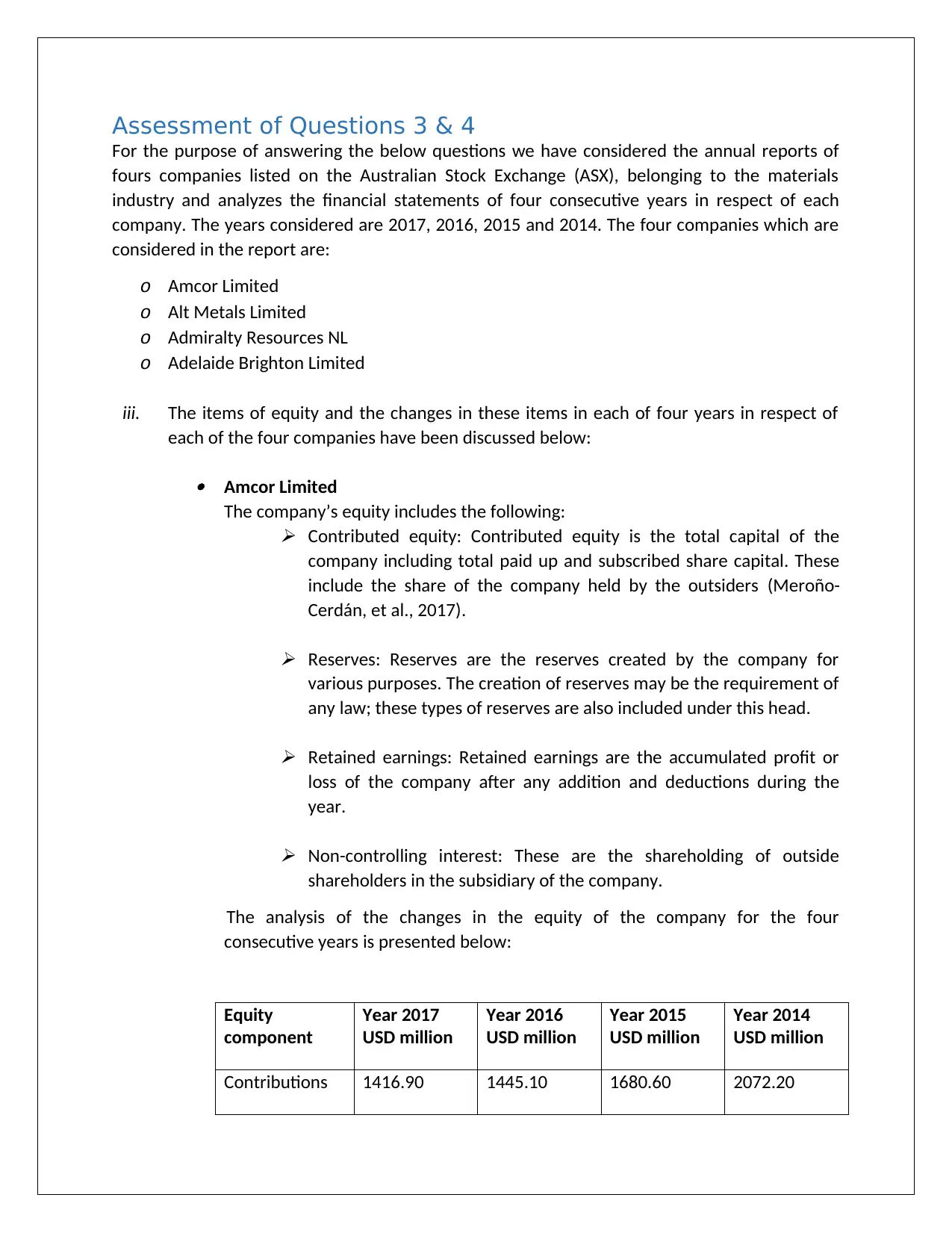
Assessment of Questions 3 & 4
For the purpose of answering the below questions we have considered the annual reports of
fours companies listed on the Australian Stock Exchange (ASX), belonging to the materials
industry and analyzes the financial statements of four consecutive years in respect of each
company. The years considered are 2017, 2016, 2015 and 2014. The four companies which are
considered in the report are:
o Amcor Limited
o Alt Metals Limited
o Admiralty Resources NL
o Adelaide Brighton Limited
iii. The items of equity and the changes in these items in each of four years in respect of
each of the four companies have been discussed below: Amcor Limited
The company’s equity includes the following:
Contributed equity: Contributed equity is the total capital of the
company including total paid up and subscribed share capital. These
include the share of the company held by the outsiders (Meroño-
Cerdán, et al., 2017).
Reserves: Reserves are the reserves created by the company for
various purposes. The creation of reserves may be the requirement of
any law; these types of reserves are also included under this head.
Retained earnings: Retained earnings are the accumulated profit or
loss of the company after any addition and deductions during the
year.
Non-controlling interest: These are the shareholding of outside
shareholders in the subsidiary of the company.
The analysis of the changes in the equity of the company for the four
consecutive years is presented below:
Equity
component
Year 2017
USD million
Year 2016
USD million
Year 2015
USD million
Year 2014
USD million
Contributions 1416.90 1445.10 1680.60 2072.20
For the purpose of answering the below questions we have considered the annual reports of
fours companies listed on the Australian Stock Exchange (ASX), belonging to the materials
industry and analyzes the financial statements of four consecutive years in respect of each
company. The years considered are 2017, 2016, 2015 and 2014. The four companies which are
considered in the report are:
o Amcor Limited
o Alt Metals Limited
o Admiralty Resources NL
o Adelaide Brighton Limited
iii. The items of equity and the changes in these items in each of four years in respect of
each of the four companies have been discussed below: Amcor Limited
The company’s equity includes the following:
Contributed equity: Contributed equity is the total capital of the
company including total paid up and subscribed share capital. These
include the share of the company held by the outsiders (Meroño-
Cerdán, et al., 2017).
Reserves: Reserves are the reserves created by the company for
various purposes. The creation of reserves may be the requirement of
any law; these types of reserves are also included under this head.
Retained earnings: Retained earnings are the accumulated profit or
loss of the company after any addition and deductions during the
year.
Non-controlling interest: These are the shareholding of outside
shareholders in the subsidiary of the company.
The analysis of the changes in the equity of the company for the four
consecutive years is presented below:
Equity
component
Year 2017
USD million
Year 2016
USD million
Year 2015
USD million
Year 2014
USD million
Contributions 1416.90 1445.10 1680.60 2072.20
⊘ This is a preview!⊘
Do you want full access?
Subscribe today to unlock all pages.

Trusted by 1+ million students worldwide
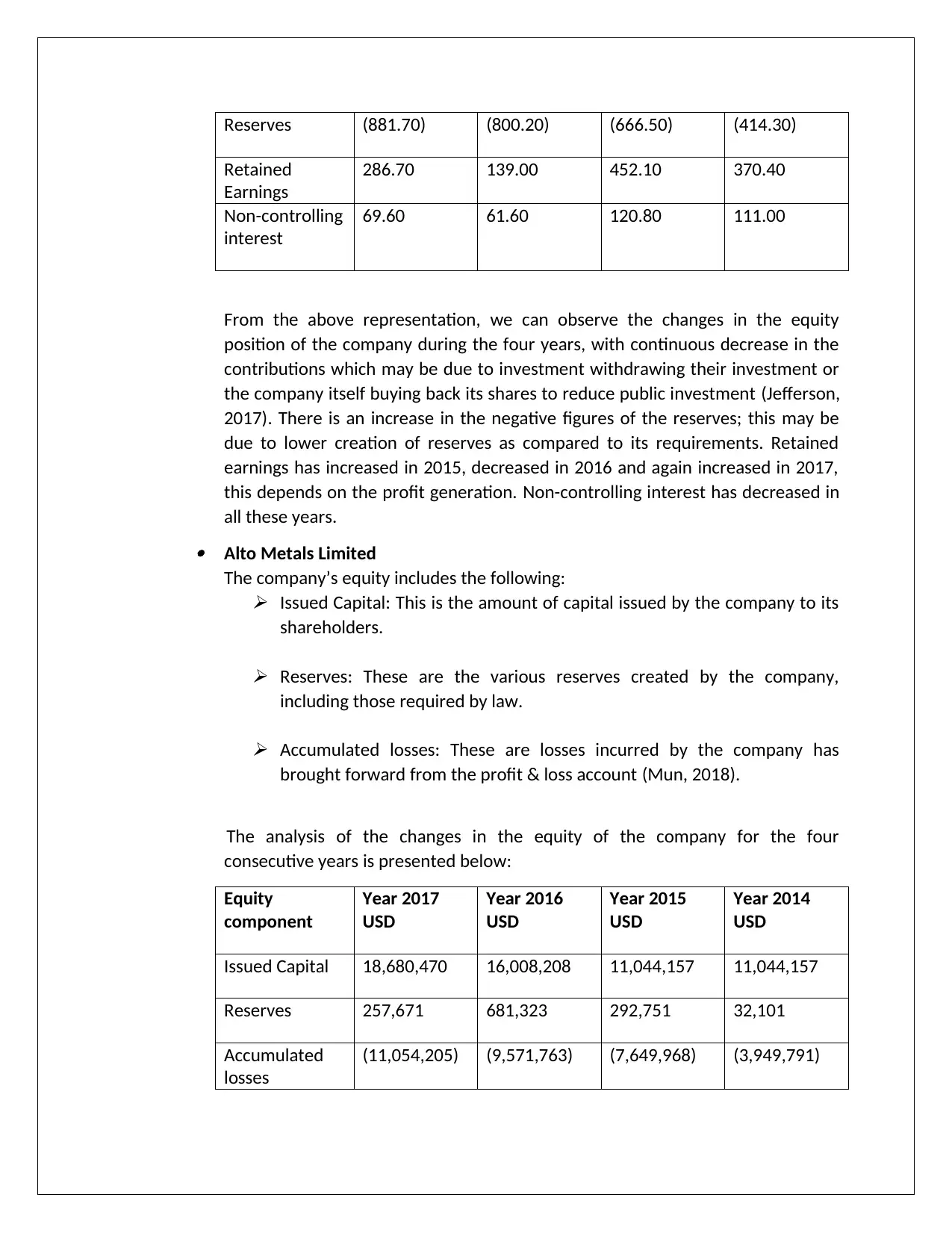
Reserves (881.70) (800.20) (666.50) (414.30)
Retained
Earnings
286.70 139.00 452.10 370.40
Non-controlling
interest
69.60 61.60 120.80 111.00
From the above representation, we can observe the changes in the equity
position of the company during the four years, with continuous decrease in the
contributions which may be due to investment withdrawing their investment or
the company itself buying back its shares to reduce public investment (Jefferson,
2017). There is an increase in the negative figures of the reserves; this may be
due to lower creation of reserves as compared to its requirements. Retained
earnings has increased in 2015, decreased in 2016 and again increased in 2017,
this depends on the profit generation. Non-controlling interest has decreased in
all these years.
Alto Metals Limited
The company’s equity includes the following:
Issued Capital: This is the amount of capital issued by the company to its
shareholders.
Reserves: These are the various reserves created by the company,
including those required by law.
Accumulated losses: These are losses incurred by the company has
brought forward from the profit & loss account (Mun, 2018).
The analysis of the changes in the equity of the company for the four
consecutive years is presented below:
Equity
component
Year 2017
USD
Year 2016
USD
Year 2015
USD
Year 2014
USD
Issued Capital 18,680,470 16,008,208 11,044,157 11,044,157
Reserves 257,671 681,323 292,751 32,101
Accumulated
losses
(11,054,205) (9,571,763) (7,649,968) (3,949,791)
Retained
Earnings
286.70 139.00 452.10 370.40
Non-controlling
interest
69.60 61.60 120.80 111.00
From the above representation, we can observe the changes in the equity
position of the company during the four years, with continuous decrease in the
contributions which may be due to investment withdrawing their investment or
the company itself buying back its shares to reduce public investment (Jefferson,
2017). There is an increase in the negative figures of the reserves; this may be
due to lower creation of reserves as compared to its requirements. Retained
earnings has increased in 2015, decreased in 2016 and again increased in 2017,
this depends on the profit generation. Non-controlling interest has decreased in
all these years.
Alto Metals Limited
The company’s equity includes the following:
Issued Capital: This is the amount of capital issued by the company to its
shareholders.
Reserves: These are the various reserves created by the company,
including those required by law.
Accumulated losses: These are losses incurred by the company has
brought forward from the profit & loss account (Mun, 2018).
The analysis of the changes in the equity of the company for the four
consecutive years is presented below:
Equity
component
Year 2017
USD
Year 2016
USD
Year 2015
USD
Year 2014
USD
Issued Capital 18,680,470 16,008,208 11,044,157 11,044,157
Reserves 257,671 681,323 292,751 32,101
Accumulated
losses
(11,054,205) (9,571,763) (7,649,968) (3,949,791)
Paraphrase This Document
Need a fresh take? Get an instant paraphrase of this document with our AI Paraphraser
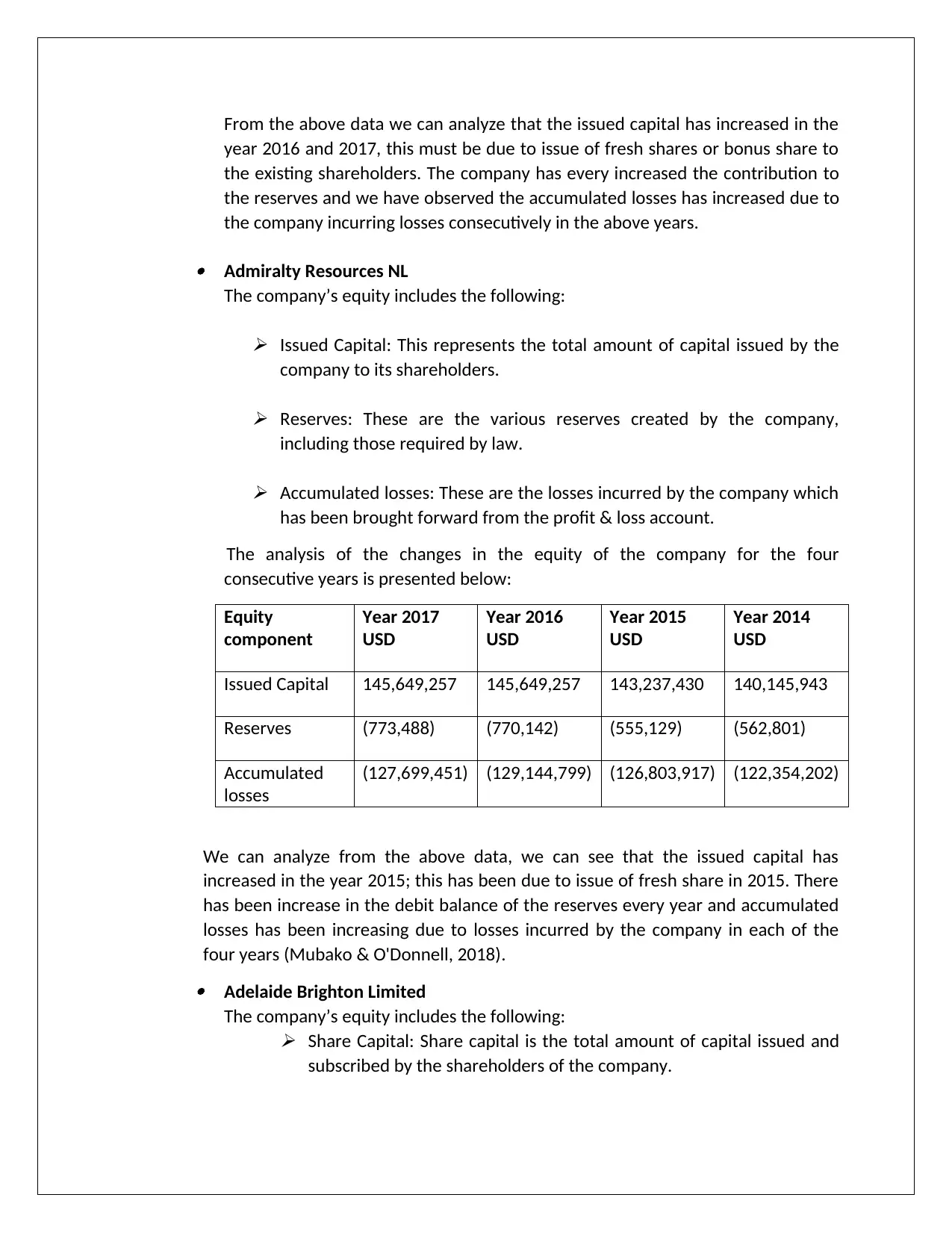
From the above data we can analyze that the issued capital has increased in the
year 2016 and 2017, this must be due to issue of fresh shares or bonus share to
the existing shareholders. The company has every increased the contribution to
the reserves and we have observed the accumulated losses has increased due to
the company incurring losses consecutively in the above years. Admiralty Resources NL
The company’s equity includes the following:
Issued Capital: This represents the total amount of capital issued by the
company to its shareholders.
Reserves: These are the various reserves created by the company,
including those required by law.
Accumulated losses: These are the losses incurred by the company which
has been brought forward from the profit & loss account.
The analysis of the changes in the equity of the company for the four
consecutive years is presented below:
Equity
component
Year 2017
USD
Year 2016
USD
Year 2015
USD
Year 2014
USD
Issued Capital 145,649,257 145,649,257 143,237,430 140,145,943
Reserves (773,488) (770,142) (555,129) (562,801)
Accumulated
losses
(127,699,451) (129,144,799) (126,803,917) (122,354,202)
We can analyze from the above data, we can see that the issued capital has
increased in the year 2015; this has been due to issue of fresh share in 2015. There
has been increase in the debit balance of the reserves every year and accumulated
losses has been increasing due to losses incurred by the company in each of the
four years (Mubako & O'Donnell, 2018).
Adelaide Brighton Limited
The company’s equity includes the following:
Share Capital: Share capital is the total amount of capital issued and
subscribed by the shareholders of the company.
year 2016 and 2017, this must be due to issue of fresh shares or bonus share to
the existing shareholders. The company has every increased the contribution to
the reserves and we have observed the accumulated losses has increased due to
the company incurring losses consecutively in the above years. Admiralty Resources NL
The company’s equity includes the following:
Issued Capital: This represents the total amount of capital issued by the
company to its shareholders.
Reserves: These are the various reserves created by the company,
including those required by law.
Accumulated losses: These are the losses incurred by the company which
has been brought forward from the profit & loss account.
The analysis of the changes in the equity of the company for the four
consecutive years is presented below:
Equity
component
Year 2017
USD
Year 2016
USD
Year 2015
USD
Year 2014
USD
Issued Capital 145,649,257 145,649,257 143,237,430 140,145,943
Reserves (773,488) (770,142) (555,129) (562,801)
Accumulated
losses
(127,699,451) (129,144,799) (126,803,917) (122,354,202)
We can analyze from the above data, we can see that the issued capital has
increased in the year 2015; this has been due to issue of fresh share in 2015. There
has been increase in the debit balance of the reserves every year and accumulated
losses has been increasing due to losses incurred by the company in each of the
four years (Mubako & O'Donnell, 2018).
Adelaide Brighton Limited
The company’s equity includes the following:
Share Capital: Share capital is the total amount of capital issued and
subscribed by the shareholders of the company.
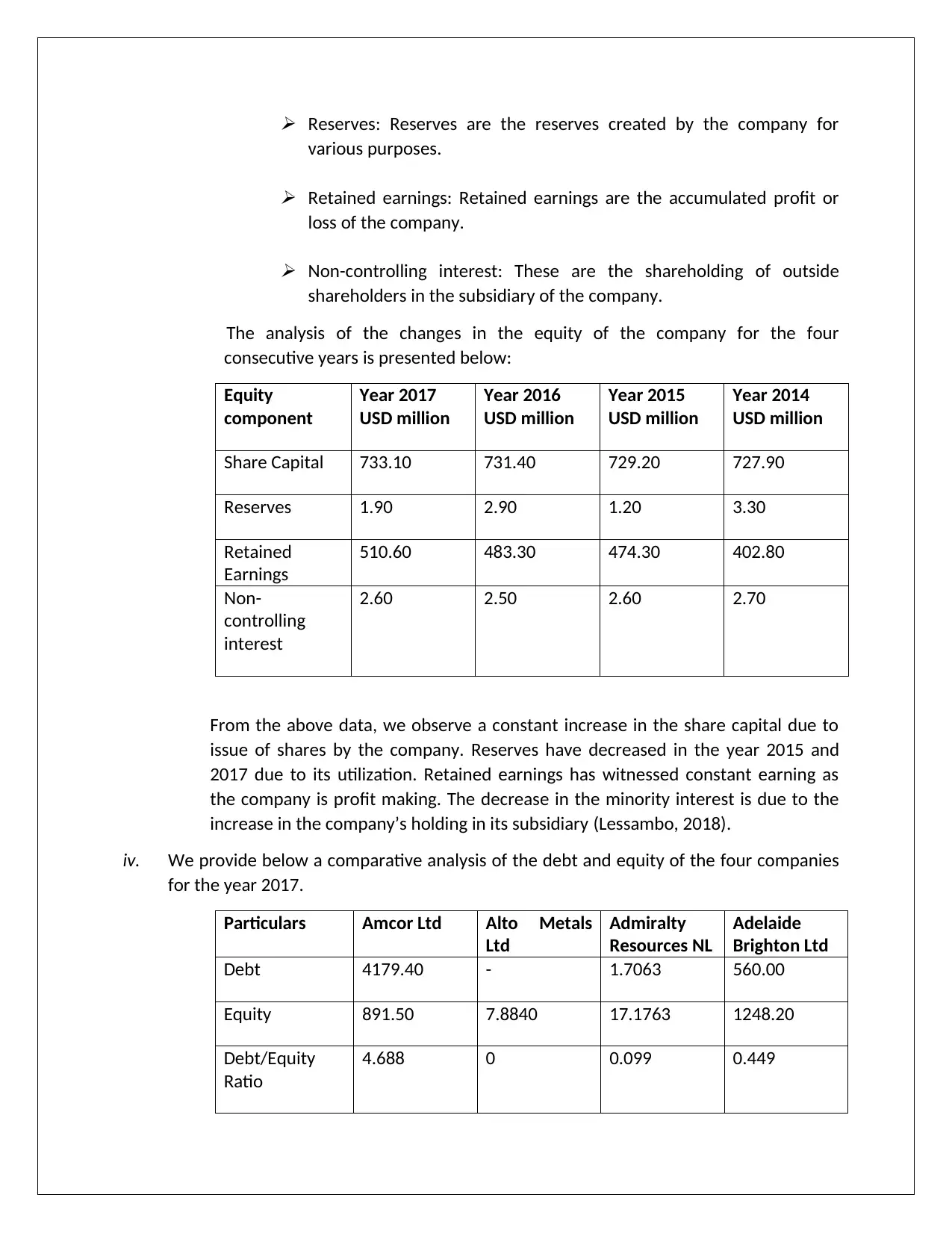
Reserves: Reserves are the reserves created by the company for
various purposes.
Retained earnings: Retained earnings are the accumulated profit or
loss of the company.
Non-controlling interest: These are the shareholding of outside
shareholders in the subsidiary of the company.
The analysis of the changes in the equity of the company for the four
consecutive years is presented below:
Equity
component
Year 2017
USD million
Year 2016
USD million
Year 2015
USD million
Year 2014
USD million
Share Capital 733.10 731.40 729.20 727.90
Reserves 1.90 2.90 1.20 3.30
Retained
Earnings
510.60 483.30 474.30 402.80
Non-
controlling
interest
2.60 2.50 2.60 2.70
From the above data, we observe a constant increase in the share capital due to
issue of shares by the company. Reserves have decreased in the year 2015 and
2017 due to its utilization. Retained earnings has witnessed constant earning as
the company is profit making. The decrease in the minority interest is due to the
increase in the company’s holding in its subsidiary (Lessambo, 2018).
iv. We provide below a comparative analysis of the debt and equity of the four companies
for the year 2017.
Particulars Amcor Ltd Alto Metals
Ltd
Admiralty
Resources NL
Adelaide
Brighton Ltd
Debt 4179.40 - 1.7063 560.00
Equity 891.50 7.8840 17.1763 1248.20
Debt/Equity
Ratio
4.688 0 0.099 0.449
various purposes.
Retained earnings: Retained earnings are the accumulated profit or
loss of the company.
Non-controlling interest: These are the shareholding of outside
shareholders in the subsidiary of the company.
The analysis of the changes in the equity of the company for the four
consecutive years is presented below:
Equity
component
Year 2017
USD million
Year 2016
USD million
Year 2015
USD million
Year 2014
USD million
Share Capital 733.10 731.40 729.20 727.90
Reserves 1.90 2.90 1.20 3.30
Retained
Earnings
510.60 483.30 474.30 402.80
Non-
controlling
interest
2.60 2.50 2.60 2.70
From the above data, we observe a constant increase in the share capital due to
issue of shares by the company. Reserves have decreased in the year 2015 and
2017 due to its utilization. Retained earnings has witnessed constant earning as
the company is profit making. The decrease in the minority interest is due to the
increase in the company’s holding in its subsidiary (Lessambo, 2018).
iv. We provide below a comparative analysis of the debt and equity of the four companies
for the year 2017.
Particulars Amcor Ltd Alto Metals
Ltd
Admiralty
Resources NL
Adelaide
Brighton Ltd
Debt 4179.40 - 1.7063 560.00
Equity 891.50 7.8840 17.1763 1248.20
Debt/Equity
Ratio
4.688 0 0.099 0.449
⊘ This is a preview!⊘
Do you want full access?
Subscribe today to unlock all pages.

Trusted by 1+ million students worldwide
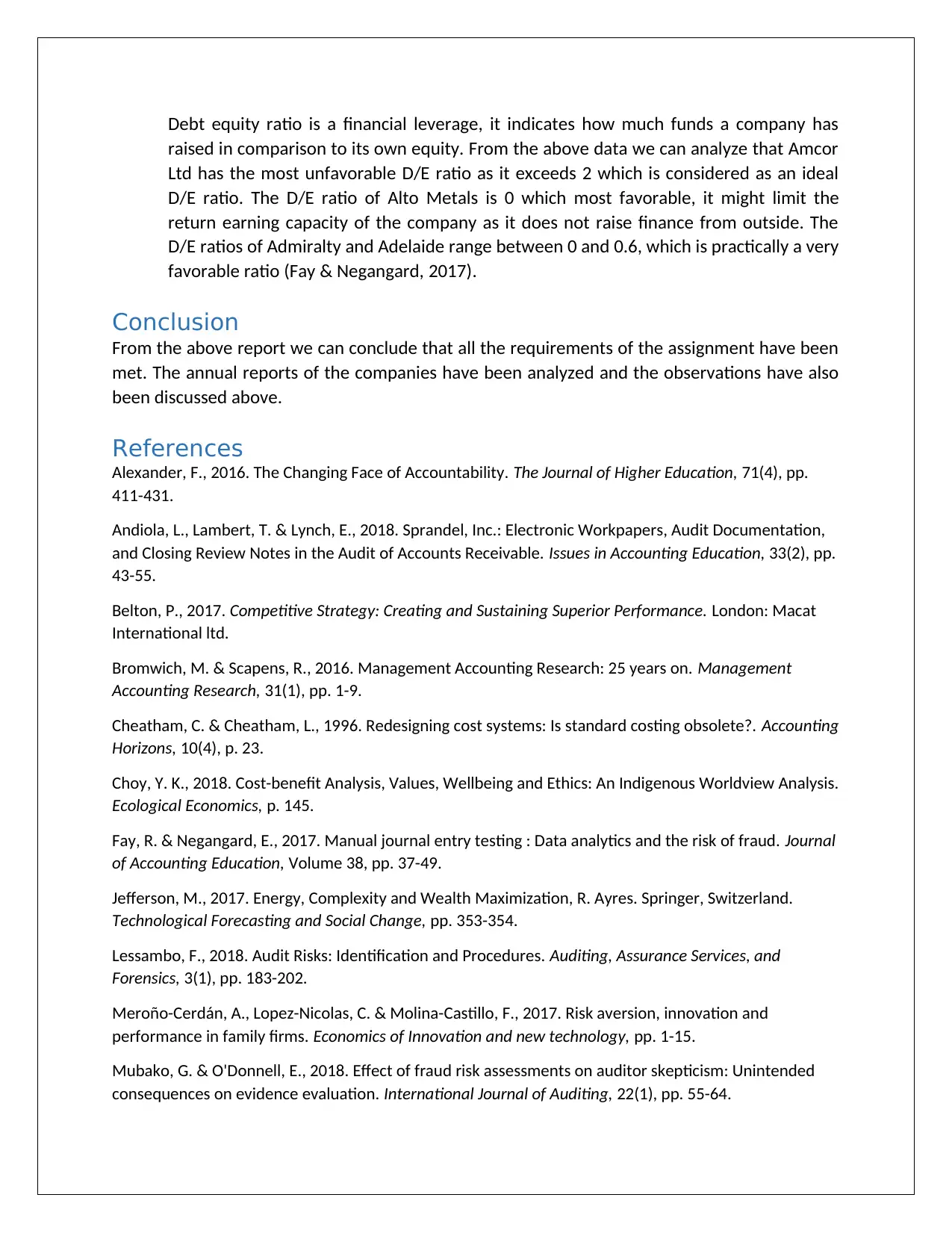
Debt equity ratio is a financial leverage, it indicates how much funds a company has
raised in comparison to its own equity. From the above data we can analyze that Amcor
Ltd has the most unfavorable D/E ratio as it exceeds 2 which is considered as an ideal
D/E ratio. The D/E ratio of Alto Metals is 0 which most favorable, it might limit the
return earning capacity of the company as it does not raise finance from outside. The
D/E ratios of Admiralty and Adelaide range between 0 and 0.6, which is practically a very
favorable ratio (Fay & Negangard, 2017).
Conclusion
From the above report we can conclude that all the requirements of the assignment have been
met. The annual reports of the companies have been analyzed and the observations have also
been discussed above.
References
Alexander, F., 2016. The Changing Face of Accountability. The Journal of Higher Education, 71(4), pp.
411-431.
Andiola, L., Lambert, T. & Lynch, E., 2018. Sprandel, Inc.: Electronic Workpapers, Audit Documentation,
and Closing Review Notes in the Audit of Accounts Receivable. Issues in Accounting Education, 33(2), pp.
43-55.
Belton, P., 2017. Competitive Strategy: Creating and Sustaining Superior Performance. London: Macat
International ltd.
Bromwich, M. & Scapens, R., 2016. Management Accounting Research: 25 years on. Management
Accounting Research, 31(1), pp. 1-9.
Cheatham, C. & Cheatham, L., 1996. Redesigning cost systems: Is standard costing obsolete?. Accounting
Horizons, 10(4), p. 23.
Choy, Y. K., 2018. Cost-benefit Analysis, Values, Wellbeing and Ethics: An Indigenous Worldview Analysis.
Ecological Economics, p. 145.
Fay, R. & Negangard, E., 2017. Manual journal entry testing : Data analytics and the risk of fraud. Journal
of Accounting Education, Volume 38, pp. 37-49.
Jefferson, M., 2017. Energy, Complexity and Wealth Maximization, R. Ayres. Springer, Switzerland.
Technological Forecasting and Social Change, pp. 353-354.
Lessambo, F., 2018. Audit Risks: Identification and Procedures. Auditing, Assurance Services, and
Forensics, 3(1), pp. 183-202.
Meroño-Cerdán, A., Lopez-Nicolas, C. & Molina-Castillo, F., 2017. Risk aversion, innovation and
performance in family firms. Economics of Innovation and new technology, pp. 1-15.
Mubako, G. & O'Donnell, E., 2018. Effect of fraud risk assessments on auditor skepticism: Unintended
consequences on evidence evaluation. International Journal of Auditing, 22(1), pp. 55-64.
raised in comparison to its own equity. From the above data we can analyze that Amcor
Ltd has the most unfavorable D/E ratio as it exceeds 2 which is considered as an ideal
D/E ratio. The D/E ratio of Alto Metals is 0 which most favorable, it might limit the
return earning capacity of the company as it does not raise finance from outside. The
D/E ratios of Admiralty and Adelaide range between 0 and 0.6, which is practically a very
favorable ratio (Fay & Negangard, 2017).
Conclusion
From the above report we can conclude that all the requirements of the assignment have been
met. The annual reports of the companies have been analyzed and the observations have also
been discussed above.
References
Alexander, F., 2016. The Changing Face of Accountability. The Journal of Higher Education, 71(4), pp.
411-431.
Andiola, L., Lambert, T. & Lynch, E., 2018. Sprandel, Inc.: Electronic Workpapers, Audit Documentation,
and Closing Review Notes in the Audit of Accounts Receivable. Issues in Accounting Education, 33(2), pp.
43-55.
Belton, P., 2017. Competitive Strategy: Creating and Sustaining Superior Performance. London: Macat
International ltd.
Bromwich, M. & Scapens, R., 2016. Management Accounting Research: 25 years on. Management
Accounting Research, 31(1), pp. 1-9.
Cheatham, C. & Cheatham, L., 1996. Redesigning cost systems: Is standard costing obsolete?. Accounting
Horizons, 10(4), p. 23.
Choy, Y. K., 2018. Cost-benefit Analysis, Values, Wellbeing and Ethics: An Indigenous Worldview Analysis.
Ecological Economics, p. 145.
Fay, R. & Negangard, E., 2017. Manual journal entry testing : Data analytics and the risk of fraud. Journal
of Accounting Education, Volume 38, pp. 37-49.
Jefferson, M., 2017. Energy, Complexity and Wealth Maximization, R. Ayres. Springer, Switzerland.
Technological Forecasting and Social Change, pp. 353-354.
Lessambo, F., 2018. Audit Risks: Identification and Procedures. Auditing, Assurance Services, and
Forensics, 3(1), pp. 183-202.
Meroño-Cerdán, A., Lopez-Nicolas, C. & Molina-Castillo, F., 2017. Risk aversion, innovation and
performance in family firms. Economics of Innovation and new technology, pp. 1-15.
Mubako, G. & O'Donnell, E., 2018. Effect of fraud risk assessments on auditor skepticism: Unintended
consequences on evidence evaluation. International Journal of Auditing, 22(1), pp. 55-64.
Paraphrase This Document
Need a fresh take? Get an instant paraphrase of this document with our AI Paraphraser
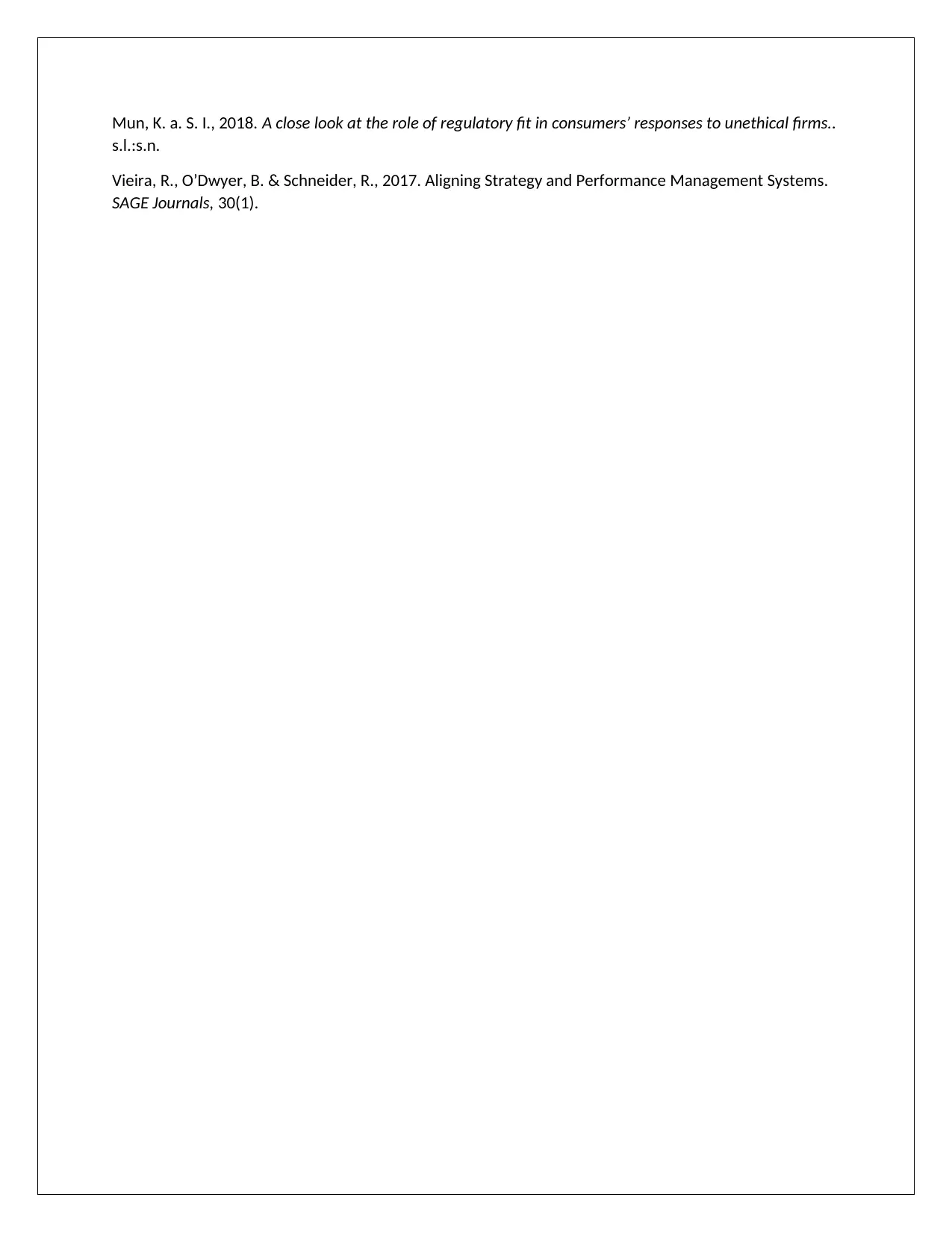
Mun, K. a. S. I., 2018. A close look at the role of regulatory fit in consumers’ responses to unethical firms..
s.l.:s.n.
Vieira, R., O’Dwyer, B. & Schneider, R., 2017. Aligning Strategy and Performance Management Systems.
SAGE Journals, 30(1).
s.l.:s.n.
Vieira, R., O’Dwyer, B. & Schneider, R., 2017. Aligning Strategy and Performance Management Systems.
SAGE Journals, 30(1).
1 out of 11
Related Documents
Your All-in-One AI-Powered Toolkit for Academic Success.
+13062052269
info@desklib.com
Available 24*7 on WhatsApp / Email
![[object Object]](/_next/static/media/star-bottom.7253800d.svg)
Unlock your academic potential
Copyright © 2020–2025 A2Z Services. All Rights Reserved. Developed and managed by ZUCOL.




